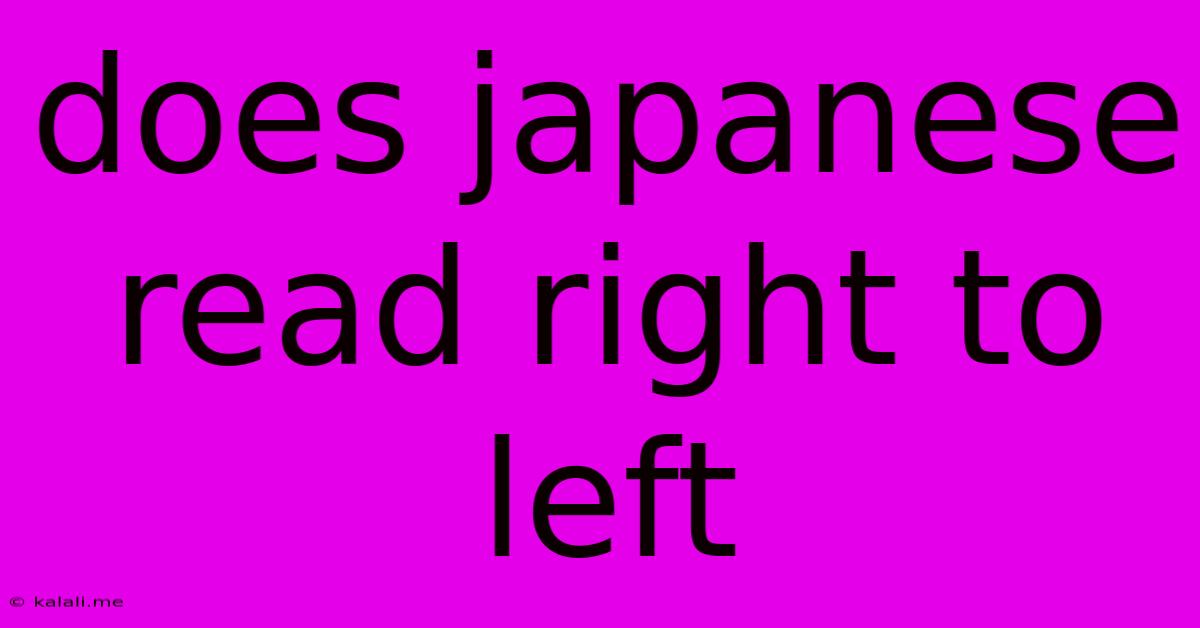Does Japanese Read Right To Left
Kalali
May 24, 2025 · 2 min read

Table of Contents
Does Japanese Read Right to Left? A Comprehensive Guide
Meta Description: Unravel the mysteries of Japanese reading order! This guide explains the complexities of reading Japanese, including horizontal and vertical writing, and clarifies common misconceptions. Learn the nuances of modern and traditional writing styles.
The simple answer to "Does Japanese read right to left?" is: no, not always. While the misconception persists, the reality is more nuanced. The reading direction in Japanese depends on several factors, primarily the type of text and its historical context. Understanding this complexity is key to navigating the world of Japanese writing.
Horizontal vs. Vertical Writing: The Heart of the Matter
Modern Japanese primarily uses a horizontal writing system, reading from left to right, just like English. This is especially true for most printed material like books, newspapers, and websites. However, vertical writing still exists, often in more traditional contexts.
When written vertically, Japanese text is typically read top to bottom, and right to left. This is a system inherited from traditional Chinese writing, and remnants of it are still seen in:
- Traditional Signage: Older signs, particularly those with a more artistic or classical feel, might use vertical writing.
- Calligraphy and Formal Documents: Certain formal documents or artistic writings may still employ the top-to-bottom, right-to-left style.
- Manga (Sometimes): While most manga reads left-to-right, some older or more traditional manga may utilize a right-to-left vertical orientation.
- Certain Books and Magazines: While less common, some specialized publications might maintain the traditional vertical format.
It's important to note that even in vertically written text, individual characters (kanji, hiragana, katakana) are themselves generally written top-to-bottom.
The Role of Kanji, Hiragana, and Katakana
The three main writing systems in Japanese – Kanji (adopted Chinese characters), Hiragana (a phonetic script), and Katakana (another phonetic script) – don't inherently dictate reading direction. Their arrangement, however, is key to determining the overall reading flow, whether horizontal or vertical.
Modernization and Reading Direction
The shift towards horizontal writing in Japanese reflects a broader modernization process, driven in part by the need for greater efficiency and international communication. This is particularly relevant in the digital age, where horizontal text dominates online content.
The prevalence of horizontal reading has made it easier for non-Japanese speakers to learn the language as it aligns with the reading habits of many other languages.
Conclusion: Navigating the Nuances
While the common practice is left-to-right horizontal reading, understanding that vertical, right-to-left reading still exists within specific contexts is crucial for a comprehensive understanding of Japanese writing. By appreciating the historical evolution and diverse applications of both styles, one can confidently navigate the fascinating world of Japanese text.
Latest Posts
Latest Posts
-
Hide Author And Type In Joomla Search Results
May 25, 2025
-
How To Say Play In Spanish
May 25, 2025
-
Checbox Com Pass Variable To Url Variable
May 25, 2025
-
Did Harry Force Mj To Break Up With Peter
May 25, 2025
-
Customer Never Refreshed Browser And Is Running Old Code
May 25, 2025
Related Post
Thank you for visiting our website which covers about Does Japanese Read Right To Left . We hope the information provided has been useful to you. Feel free to contact us if you have any questions or need further assistance. See you next time and don't miss to bookmark.